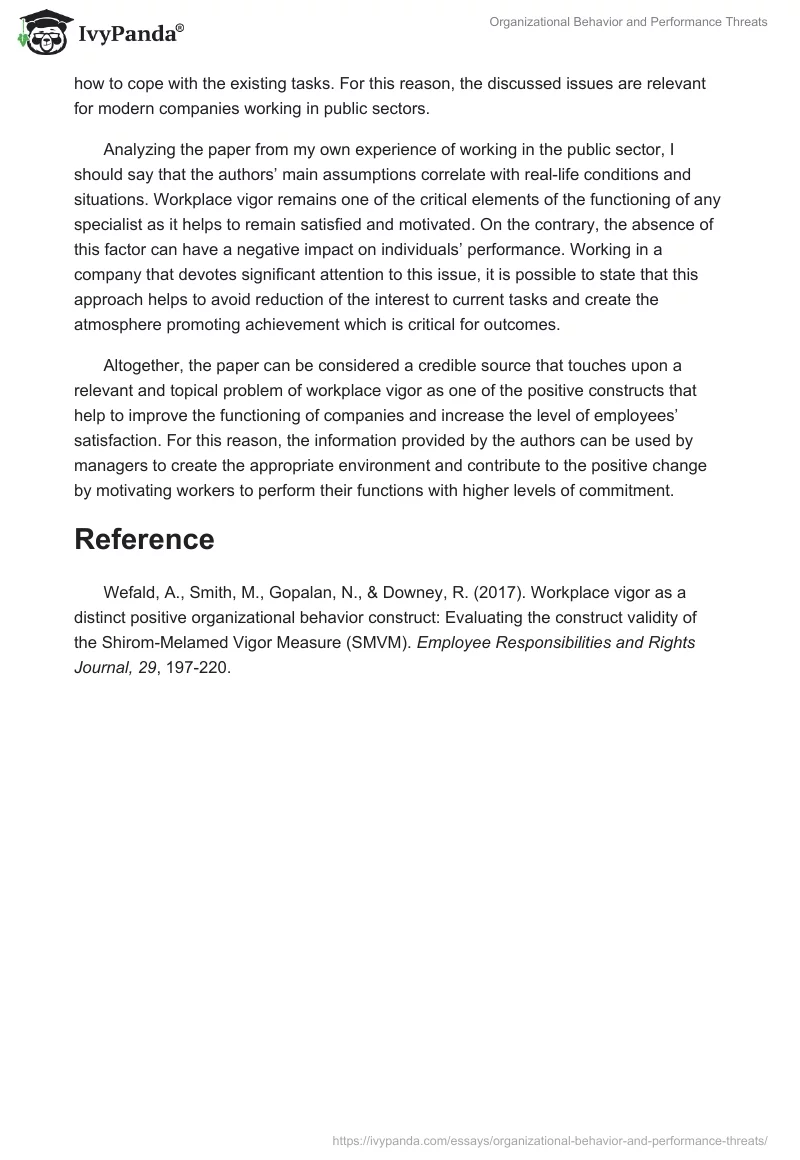The discussed paper is devoted to the problems of organizational behavior and other factors impacting performance. Wefald, Smith, Gopalan, and Downey (2017) are interested in the evaluation of distinctiveness of workplace vigor and the impact it might have on organizations. For this reason, they utilize the Luthan’s five criteria for determining a construct as a unique which are theoretical grounding, validity measured, unique to organizational behavior, state-like, and positive impact on satisfaction and performance (Wefald et al., 2017).
To conduct their study, investigators engaged 693 employees from 56 restaurants to investigate the effect of vigor on positive organizational behaviors (Wefald et al., 2017). In the course of the investigation, the authors conclude that there is a positive correlation between the investigated phenomena as there is the appearance of positive shifts in employees and tendencies towards the improved effectiveness and outcomes.
Regarding the selected issue, the article can be considered an important source that delves into one of the critical aspects of companies’ functioning which is a workplace behavior. The researchers try to outline approaches that can be used to achieve better results and evaluate their effectiveness in driving positive change (Wefald et al., 2017). Accepting the fact that it is one of the main tasks of an effective manager, the paper can be considered a credible source of knowledge that can help to acquire an improved understanding of how vigor can workplace vigor can be utilized as a positive organizational construct that contributes to the achievement of outlined goals.
The increased relevance of the information presented by the authors can also be evidenced by the existence of multiple options for its application to the work of the public sector. In the majority of cases, the positive results in the given segment are associated with the high levels of satisfaction and work engagement (Wefald et al., 2017). For this reason, organizations belonging to this sphere should strive for the achievement of high workplace vigor levels as one of the key factors that will boost performance and help to attain success. At the same time, it will help to improve the attitudes of employees to their duties and reconsider their perspectives on the ways how to cope with the existing tasks. For this reason, the discussed issues are relevant for modern companies working in public sectors.
Analyzing the paper from my own experience of working in the public sector, I should say that the authors’ main assumptions correlate with real-life conditions and situations. Workplace vigor remains one of the critical elements of the functioning of any specialist as it helps to remain satisfied and motivated. On the contrary, the absence of this factor can have a negative impact on individuals’ performance. Working in a company that devotes significant attention to this issue, it is possible to state that this approach helps to avoid reduction of the interest to current tasks and create the atmosphere promoting achievement which is critical for outcomes.
Altogether, the paper can be considered a credible source that touches upon a relevant and topical problem of workplace vigor as one of the positive constructs that help to improve the functioning of companies and increase the level of employees’ satisfaction. For this reason, the information provided by the authors can be used by managers to create the appropriate environment and contribute to the positive change by motivating workers to perform their functions with higher levels of commitment.
Reference
Wefald, A., Smith, M., Gopalan, N., & Downey, R. (2017). Workplace vigor as a distinct positive organizational behavior construct: Evaluating the construct validity of the Shirom-Melamed Vigor Measure (SMVM). Employee Responsibilities and Rights Journal, 29, 197-220.


